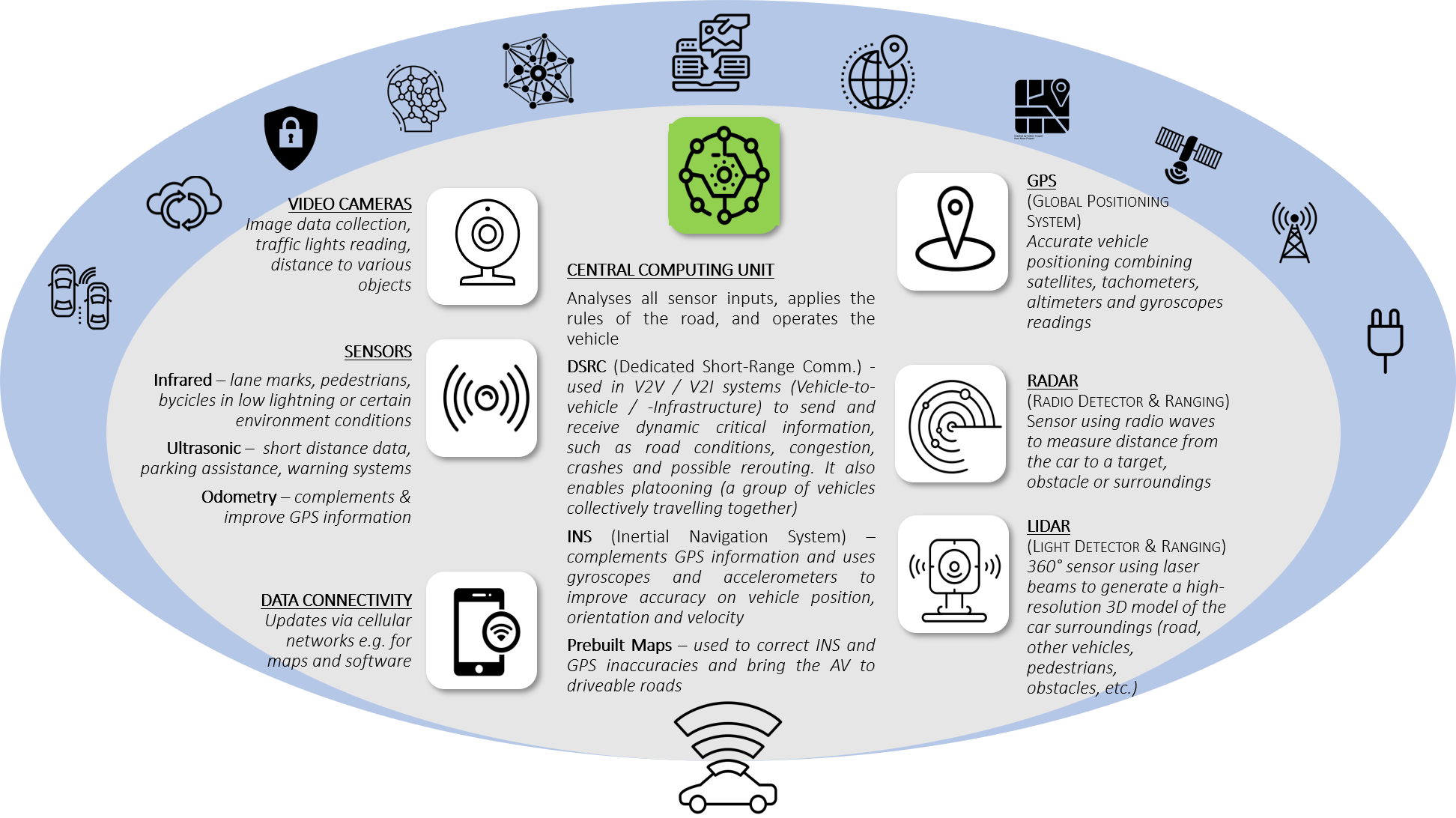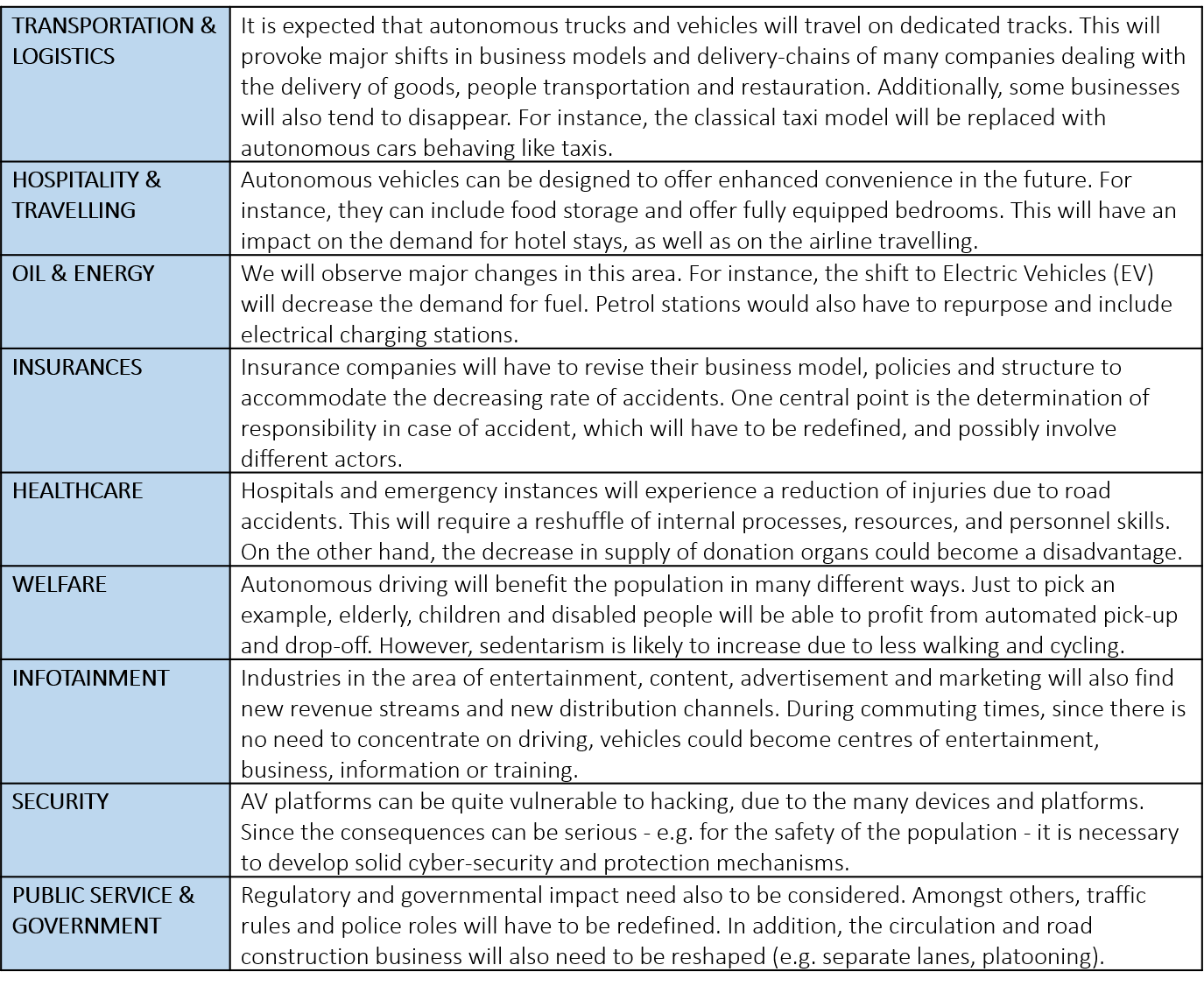Autonomous vehicles – driving the next highway of global disruption
März 17, 2021
März 17, 2021
When we try to imagine how the future will look like, the vision of Autonomous Vehicles (AV) always comes forward. As technologies around AVs will mature, the impact on the mobility industry will be huge. But above all, such a breakthrough is also susceptible to trigger a huge disruption over other sectors, which at first sight are not even remotely related.
The automotive industry worldwide is facing major challenges. Firstly, accident rates are still quite high, and 94% are still caused by human error. Secondly, traffic congestion is contributing to excessive pollution. Finally, energy consumption needs to be rationalised. Self-driven devices can partially provide an answer to some of these challenges, and as such consequent investments are being made in the development of new enabling technologies.
Per definition, an Autonomous Vehicle (AV), also known as self-driving car, enjoys of four main attributes: 1) a connected vehicle, 2) able to sense its environment and 3) guide itself, 4) considering and respecting all safety guidelines and constrains.
The SAE has defined five official levels of driving automation (J3016 standard). These range from simple driver assistance to full automation, as illustrated below in terms of successive operator autonomy steps.
As technological enhancements will happen, the AV will replace the human in all driving tasks, under all types of dynamic, roadway and environmental conditions. But today, only levels 1 and 2 cars are broadly commercialised. These are simple assistance systems, and still heavily dependent on human intervention.
Level 3 vehicles are also being sold today, even if some security issues still need to be refined (IEEE Spectrum). namely in which regards the practicability in city traffic context, as opposed to highway driving. Once this is achieved, they can be deployed at large scale as full level 3 “hand-off” vehicles. Finally, the technology complexity required to get from level 3 to levels 4 and 5 autonomous driving remains huge.
In short, a full automated vehicle will not become mainstream before the end of this decade. However, many industries should get ready in the meantime, for the impact it will create in the future.
About the author
Helia Burgunder is an inspirational C-Level executive bringing over 27 years of accomplished track-record with leading corporations in the ICT industry, in Switzerland and Europe, successfully spearheading cross-functional operations in the B2B and consumer markets. Helia earned an MBA from the University of Fribourg, a Master’s Degree in Computer Science & Electrical Engineering from the University of Lisbon and a Certificate of Advanced Studies in Disruptive Technologies. She currently serves on several Boards of Directors.
To perform all the complex tasks that enable autonomous driving from level 3 onwards, the AV relies on a two-layer IoT-based interaction model. Illustrated below are some of the elements contained within each circle. The inner circle represents the “micro-ecosystem”, in other words, the local AV platform made of in-car software and hardware. All elements are then connected to a “macro-ecosystem” of external global elements. These are for instance data collection and analytics platform; Artificial Intelligence (AI) and Deep Learning (DL), location services, telematics and security systems; as well as communication, cloud, payment, content and service delivery platforms, amongst others.

All “micro-ecosystems” communicate amongst them, as well as with the macro-ecosystem. Such a model made of all sorts of interconnected sensors and platforms requires demanding capabilities. Amongst these are accrued real time and accuracy, real-time traffic control, safe communication between vehicles and sensors, as well as high-quality mobile Internet access for the passengers. Understanding the basics and the magnitude of this future mobility landscape helps seizing how such technological breakthroughs are also likely to disrupt other industries
The impact prompted by AVs on the car industry itself is just a small part of the puzzle. Once the whole ecosystem is in place, it will affect many other industries, creating new market opportunities and business models. They following lines briefly exemplify some of these discontinuities. However, this list is far from being extensive.

Quelle: Helia Burgunder, CAS Disruptive Technologies
The consequences of this disruption are not clear yet. In fact, certain impacts can create opposite forces, capable of neutralising each other.
For instance, a substantial decrease of traffic-driven CO2 emission is expected to happen through car-sharing/sharing, as a result of autonomous cars. However, increased car demand may also happen, if on-demand mobility starts to displace public transportation alternatives (e.g. bus, metro, train) towards AV solutions.
Similarly, opinions are also mitigated regarding weather AVs will save energy. On the one hand, there will be less need for parking areas in city centres. Such spaces become available for urban housing, which leads to less people commuting daily – thus to a reduction of energy consumption. On the other hand, AVs will increase productivity during commuting times. From this perspective, rural areas can become more attractive for living. This means more frequent and longer trips, and possibly greater traffic congestion – which would increase energy consumption.
Autonomous Vehicles will trigger a wave of disruption across numerous industries, and the impact on society, environment, and businesses still needs to be better understood. But at the end of the day, one needs to remember that this is “only” technology. Most importantly, is what mankind will make out of it. It’s in our hands to use it for shaping a better brand-new world.
Sources:
Khayyam, Hamid & Javadi, Bahman & Jalili, Mahdi & Jazar, Reza. (2020). Artificial Intelligence and Internet of Things for Autonomous Vehicles. 10.1007/978-3-030-18963-1_2
“Automated Driving – Levels of Driving Automation are Defined in New SAE International Standard J3016” (PDF). SAE International. 2014. Archived (PDF)from the original on 1 July 2018. https://en.wikipedia.org/wiki/Self-driving_car#cite_note-SAE_definitions-57
IEEE Spectrum, Accelerating Autonomous Vehicle Technology https://spectrum.ieee.org/transportation/self-driving/accelerating-autonomous-vehicle-technology
Larson, William; Zhao, Weihua (2020). “Self-driving cars and the city: Effects on sprawl, energy consumption, and housing affordability”. Regional Science and Urban Economics. 81: 103484. doi:10.1016/j.regsciurbeco.2019.103484. ISSN 0166-0462.
Adams, Ian (30 December 2016). “Self-Driving Cars Will Make Organ Shortages Even Worse”. Slate. Retrieved 9 November 2018.
Saunders, John (10 August 2020). “How can autonomous cars help reduce accidents?”. London Business News | Londonlovesbusiness.com. Retrieved 29 August 2020.
https://www.fierceelectronics.com/components/three-sensor-types-drive-autonomous-vehicles
https://www.greencarcongress.com/2019/01/20190115-baidu.html
https://www.youtube.com/watch?v=tj1VK431dNs
http://reports.weforum.org/digital-transformation/the-driverless-car-revolution/
Unser Newsletter liefert dir brandaktuelle News, Insights aus unseren Studiengängen, inspirierende Tech- & Business-Events und spannende Job- und Projektausschreibungen, die die digitale Welt bewegen.